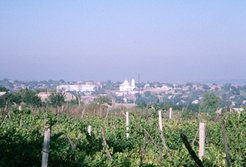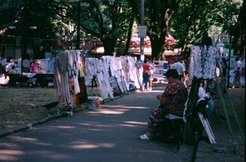Project 2: Comparing Rural Property Relations in Bulgaria and Ukraine
Project Summary

The main aim of this project is to examine different forms of property that have been under negotiation in the course of postsocialist reforms in Ukraine since 1991. A second dimension of the study is to compare the findings with Bulgaria , which was my first region of expertise and which I have maintained as a field site since the mid 1980s. A comparison of these two countries offers a means for understanding the development of reforms in the wider east European rural context.

The Ukrainian research involved setting up a new field site in a village in the southern most part of the Odessa oblast where I lived for a year. Aware of the importance of land reform issues in Bulgaria , I soon realised that land was only one resource under negotiation in the context of wide-sweeping reforms in Ukraine . Thus a number of differing forms of property constituted the focus of my research and are central concerns of the book I am presently completing.
In rural Ukraine - as in many other former USSR republics - land has been the foremost resource privatised. ‘Work’ and ‘land use’ have provided the basic criteria for distributing the land; providing the framework for the disestablishment of the kolkhoz and sovkhoz and the creation of at least four identifiable ways in which agricultural production is presently taking place. Firstly, most land is owned by ex-sovkhoz and kolhoz members (who have received a standard sized plot) and cultivated by successor cooperatives. Secondly, a number of informal groups, comprised of (ex-)social sphere employees (those that supported the agricultural collectives e.g. the teaching and medical professions) manage small tracts of land collectively. They are entitled to equally-sized plots, but these are significantly smaller than those conferred to ex-agricultural workers. Third, a small number of private farms have been established by ex-collective workers with experience in a wide variety of agricultural tasks (a rare quality in the socialist collective where occupations were usually specialised). Finally, as in Bulgaria , and indeed across eastern Europe, the vast majority of villagers maintain a household plot. Families have become increasingly dependent on produce from this plot in the context of a weakened state with shrinking resources, high unemployment and ever-increasing prices. Variation in how land is worked and owned in the Ukraine case, and the apparent lack of opposition to private farming – despite a strong community emphasis on social equality - can be attributed to a number of factors: the successful farmers do not flaunt their wealth through investment in luxurious lifestyles (big houses etc), indeed they share their success with the community through providing, for example, the school with free wheat for bread at school meals. In any case the majority of farmers do not own much more land than other villagers (since most is rented) and their success is generally viewed as well-deserved due to their hard work (see my coauthored chapter with Yalcin-Heckmann 2003).
Project 2: Comparing Rural Property Relations in Bulgaria and Ukraine

A comparison with my Bulgarian fieldsite, only 400 km south of the Ukraine site, suggests several contrasts. The criteria used to allocate land have significantly shaped new forms of agricultural production and related problems. In Ukraine (and this is true for most of the former Soviet Union ) land reforms have been carried out on the basis of the type of work performed during the socialist period and land use entitlement. In Bulgaria , restitution to pre-1944 owners has been the main criteria. In both cases, this has led to a renewed importance of kinship, although in quite different ways. But in the Bulgarian case it has also openly polarised the country, creating historically rooted political divisions between the rural and urban areas (see CV for various publications on this topic). In Ukraine an increasing number of individuals are taking their land out of the cooperatives in order to work it together with the land of other family members and friends. This is partly in response to the disappointing rent that the successor and still dominant cooperatives offer. But it differs considerably from the Bulgarian case where demographic factors (high elderly population in rural areas), as well as greater historical and ideological commitment to cooperative forms of farming, contribute to the lack of small, household based farming groups. Further, reforms in Ukraine have been more drawn out - partly as a result of greater resistance to them at the national and regional levels. This has meant that, locally at least, the same figures who were powerful during socialist times still retain power. In the Bulgarian context a notable shift in local power relations is evident (see Who Owns the Past? 2004). Lastly, reforms in Ukraine have been more wide reaching in the respect that they include the privatisation of various resources - water, some housing and so on. This was not the case in Bulgaria where the socialist cooperatives never had such vast control over local life in the first place.
This last point alerted me to the need to look at property from a broader perspective. Land, though important, was not the only resource at the centre of Ukraine village reforms and changing ideas about property. In the case of water, control has moved from the kolkhoz and sovkhoz to the village municipal council. Occurring in parallel with a growing dependency on household production, this has created a new source of local tension. In recent years the survival of the household depends on plot production, unlike the Soviet period when villagers bought most of their fruit, vegetables and meat at subsidised rates from the kolkhoz and sovkhoz. The new importance of water arises from this increased tending of household plots and has resulted in squabbles between neighbours and between different areas of the village with unequal access to water. Less tangible ‘properties’ are also under negotiation. The cosmological order, for example, is a battleground as the newly prominent Orthodox priest struggles to regain control over the moral domains of village life after 50 years of socialism. ‘Culture’ can also be viewed as a form of property that is being renegotiated in the context of the newly emerging independent Ukraine state – here it is local identity which is the resource under review. The village at the centre of my Ukrainian research is ethnically Bulgarian, and yet many inhabitants embroidered Ukrainian cultural objects at the local sewing centre. Handicrafts are an important marker of identity. Through the production of Ukrainian style embroidered objects, villagers carved out a new position for themselves vis-à-vis the newly emerging independent state, as Ukrainian citizens with minority group status.


